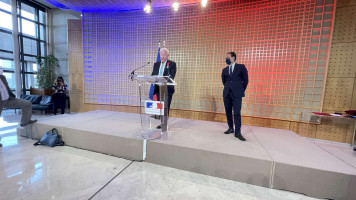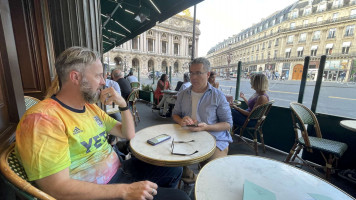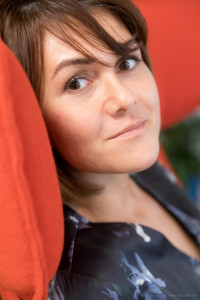This is the last part of my report of the Traveling Geeks tour in Paris before Leweb.
We met with Orange to have a glimpse of all the solutions they provide to their consumer customers: IPTV, mobile solutions, web solutions, tablets, etc. It took place in the Orange Lab situated at Chatillon, in the southern Paris suburb.
We were quite well welcomed by marketing, communication and product folks in their showroom, including Stéphanie Hospital (Marketing and Bizdev VP in the Audience and Advertizing Division, in between the geekettes below) and Eric Barilland (Electronic Medias Directors).
Telecom companies, particularly those offering triple-play solutions to their consumers, are willing to offer as integrated solutions as possible. Orange is not an exception and is favoring vertical integration of its solutions, while still working on developing an ecosystem of third party solutions. What’s interesting is they don’t mention the startups they use to source most of their services, whether software or hardware. They prefer to mention strategic partnerships with powerhouses like Cisco, Microsoft, Facebook or Intel. It’s even quite difficult to identify what’s insourced and outsourced in these various solutions. Although Orange (aka France Telecom) has put in place an “open innovation” process, it doesn’t show up enough in the way they communicate about it.
They structure their marketing in quarterly “collections” gathering all new hardware, software and web services. Many of these are now introduced in a fast-track process branded “TTM” for “Time To Market”. The latest collection, for November 2009, is describe here. It’s a good way to structure their messages and sequence media solicitations, but they still have such a broad offering that you can easily get lost.
So, what did we see in the Orange Lab showroom?
Hardware solutions
- Their new LiveBox introduced in spring 2009, a DSL modem to serve their 12 million worldwide broadband customers (1st in Europe, includes 5m IPTV customers). Supports Wifi 802.11n, has 4 Ethernet ports, supports both ADSL and FTTH, front
 buttons to activate/desactivate Wifi, and to connect Wifi devices without using WEP keys and UPnP/DLNA support.
buttons to activate/desactivate Wifi, and to connect Wifi devices without using WEP keys and UPnP/DLNA support. - Their new IPTV set-top-box, with the same look than the DSL modem, a consistency rarely seen in the telco space. It has a media center feature enabling access to the content from your home network devices (DLNA compatible). It’s an hybrid box supporting both IPTV and DVB-T (terrestrial digital TV) or DVB-S (satellite TV, to show-up in 2010), all in HD. It has an embedded PVR (personal video recorder) of 160 Gb that is extensible through an external USB drive. Orange wants to go beyond Yahoo’s widgets vision with more integration between TV channels and Internet widgets and applications. They provide developers with their own APIs to do so, with some support of Open IPTV Forum and of the new hbbtv consortium APIs. Their EPG (electronic program guide) for catch up is however quite simplistic, with no shows bookmarking or list. The UI is that of old generation STBs. You’ll have to wait till they release in about a year their Intel based STB, supporting animated user interfaces. Their “time machine” contains four weeks of shows history. Afterwards, it’s “VOD” with a catalog of 4000 movies. Things can easily get confusing between PVR, catch-up and VOD. You got to know that non-movies stuff has to be recorded or watched in catch-up mode, while movies can be played through the three mechanisms. The first being the less expensive since included in the 30 Euros/month subscription. Movies catch-up is priced at 12€ per month and VOD is on a pay per view mode. They did show us Orange Sport, an IPTV application for watching sports events, with rich content around the TV stream (below).
- A 3G Wifi router/modem to be used in regions with no DSL, using a 3G connection and SIM card.
- The Tabbee, a tablet positioned as a secondary home TV, bathroom tablet, digital picture frame. Uses Wifi to connect to DSL broadband router. Built by Sagem and using Linux and some internal (?) middleware. It’s shipped for 250 Euros with a couple applications including “Cookineo” for getting cooking recipes. Cookinero is a service built by Domolib, a Parisian startup incubated by Agoranov.
They also showcase a small Hi-Fi Decoder, used to stream music in any room, for 69€. It’s not linked to a particular service. You connect it to your amplifier and control it with a flat remote.
Orange web sites
Orange chose a while ago to run its own consumer web services. I still wonder how they could succeed with these besides a couple exceptions. They launched Pikeo for pictures sharing but it hardly competes, even in France, with Flickr or Picasa. Many of these web sites are telco neutral, meaning anybody can use it and not just consumers with a Livebox. How can a vertically integrated player become significant as a horizontal player? No idea.
They presented a couple new web sites recently launched or currently in beta:
- videoparty.fr is a catch-up and video on demand web site. Some contents are free (such as music clips), VOD is on a pay per view for anybody, and some contents are exclusive for Orange customers. You can search programs, get some recommendations, share with friends what you like, organize a video party, open it to everybody.
- tendancesanté.fr is a healthcare site aimed at mothers. Orange is partnering with the paper magazine “Santé Magazine” to get content. They’ll launch a related mobile application for the iPhone early in 2010. This competes with the local leader, Doctissimo. I heard about the Healthcare business at Orange not really doing well. A market difficult to penetrate.
- Cityvox is a city guide Orange has acquired in 2008. The site is popular and there is a lot of competition in that space.
- 2424actu.fr is a video and radio news aggregation web site showcasing in its home page the most important news. Then, you can access the most relevant video/audio and all others. Orange has made deals with local news providers (TV, radio, news agencies like AFP) so all the content is legit. Obviously, it’s got a search engine, and it can search text in audio. It does face and voice recognition. Content can be rated by viewers, posted as links to social networks. It would be good to have such a tool in IPTV set-top-boxes and to use it with a remote.
The Orange team also presented “On”, their new mobile social network hub. It’s available free of charge to all mobiles regardless of the carrier. Support starts with Android and will come to iPhone, Blackberries and others. It enables the mobile user to get their status and how to best contact his/her friends and send emails, SMS, voice messages, messages in social networks.
They mentioned a wealth of other services, some being specific to other countries where Orange operates: a partnership with wikipedia to enrich content sites (in Poland) including ads sharing (quite new for Wikipedia), a Twitter deal in the UK.
At last, let’s mention the formal launch of AppShop at Leweb. The Orange approach is without any surprise. All mobile platform are supported besides the iPhone which has its own AppStore. Developers get their usual 70% share of revenues.
Traveling Geeks Epilog
I should also mention that we had dinner with folks from Mobile Globe on Sunday evening. This startup provides a solution to make cheap calls with your mobile when calling abroad, wherever you come from.
The stay in Paris didn’t end with all these visits since we were together during Leweb. We went to parties, visited the Paris City Hall and had dinner. We shared views on Leweb, and I’ll cover that later.
The climax of these two days was Robert Scoble’s outing on those damn startups who didn’t have a Twitter account, but also a contact name in their web sites. And Eliane Fiolet who asked him to be nicer with the folks around the table. Robert explained in details why he went nut during that meeting. Most of these rules make a lot of sense but it may be slightly different when you sell “business to business” and don’t need a broad reach buzz.
Renee Blodgett makes a sound contribution in a comment for that post: there are many issues startups face and not just being or not on Twitter. There are many rules of the game that French startup don’t know, even within France, and there are many more when you want to sell in international markets. And not just in the USA. In Asia, cultural differences and business habits are different as well, and not the same as in the USA. You need to learn about it if you want to do business there. The French folks here should certainly better learn all these rules instead to trying to bent the rules, or to refuse it. Although extremely rude in its format, Scoble’s point has had some impact on the visited startup. They have learned the hard way stuff they should do. Some just created a Twitter account!
But many startups make mistakes, all over the world, and even in the US. To have a glimpse of these, just look at the KillerStartups site which presents five news startups each and every day, mostly from the USA!
Other reports
Here are some other reports from the Traveling Geeks on the two days Paris tour before Leweb:
- David Spark’s video reports of day 1.
- Tom Foremski’s “Putting French back into entrepreneur” and its welcomed positive stance on entrepreneurs he met in Paris.
- Mathew Buckland summarizes the startups seen on day 2.
- Beth Blecherman finds out that “Traveling geeks like their gadgets”.
- Kim-Mai Cutler writes on Pearltrees and on Stribe.
- Ewan Spence has a personal retrospective of the tour.
- Renee Blodgett writes about Pearltrees.
- Sky writes on what it takes to manage the IT underlyings of the TG tour.
And again, as a reminder, my (nice) pictures from these three days on Picasa (Sunday dinner included) are in this blog’s galleries running the custom Photo-Folders plugin.
Now I’m done with the TGs, I can move forward and cover Leweb…
![]()
![]()
![]()
Reçevez par email les alertes de parution de nouveaux articles :
![]()
![]()
![]()


































 Articles
Articles
I’m desoled, but I don’t write good in english. Please, read in French, if you can….
Espérons que toutes ces startups aboutiront à quelque chose et ne se feront pas rachetées tout de suite. Quoique leur business model est un peu juste (non?). Tous ces spécialistes, journalistes voyageurs… ont peut être une vue d’ensemble maintenant sur la position de la France par rapport à d’autres pays dans ce domaine.
J’ai l’impression que les Pearltrees et autres Stribe (le gagnant du prix leweb 2009) ont fait un tabac. Je crois que vous les aviez déjà présentés dans un de vos posts ici. Vous aviez indiqué que Stribe (pour son classement TechCrunch) était soutenu par ParisTech, Scientipole et Oséo. Mais j’ai lu dans divers petits blogs, que Pearltrees a levé plus de 2 millions d’euros chez les business angels et aussi été soutenu financièrement par l’Oséo qui l’a classé comme “innovation de rupture” (ça veut dire quoi?). Je ne sais pas s’ils sont intégrés dans les pôles de type cap digital, la cantine, etc. qui en profitent pour se mettre en valeur. Mais ils ont l’air de se débrouiller pas si mal malgré tout.
http://twitter.com/patricelamothe/status/1585729379 http://blog.pearltrees.com/?p=4021
http://altaide.typepad.com/jacques_froissant_altade/2009/10/index.html
A part ça, j’ai bien rigolé avec la démo de Jack Dorsey pour la solution de micro-paiement proposée par Twitter. Vous en parlerez dans vos prochains articles sur l’événement ?
http://owni.fr/2009/12/10/meme-jack-dorsey-peut-rater-une-demo/
Je vois qu’Orange garde le moral, malgré ce qui se passe chez France Telecom. C’est tant mieux. On va “changer le monde” (we going to change the world)
http://www.dailymotion.com/video/xbfzd8_lipdub-ump-la-video-virale-entre-en_news
Dailymotion (renfloué par le FSI) n’est pas censuré heureusement.
Bests regards…
Pearltrees was rather independant. Besides Oseo, they didn’t need the help of other publicly funded organization. Easily explained by their initial seed funding of 2.5m€ (or 2.0m). Companies requiring public funding are usually those who have a hard time finding initial seed funding. Sometimes, because their project is not matured enough, others, when their founders don’t have a good personal network or know how to create it.
@macha et olivier
Il vaut mieux voir Orange s’interesser comme cela à tout ce petit monde dynamique des startups web. Car l’audit de Technologia sur le stress qui règne à FT est accablant et l’arrivée de Free fait peur aussi avec sa licence 3G. C’est cela aussi la société numérique qui pourtant va recevoir 4 milliards dans le grand emprunt… Ca promet.
http://www.lefigaro.fr/entreprise/2009/12/14/05011-20091214ARTFIG00512-l-enquete-de-technologia-accable-france-telecom-.php
http://www.numerama.com/magazine/14707-orange-free-est-un-concurrent-redoutable.html